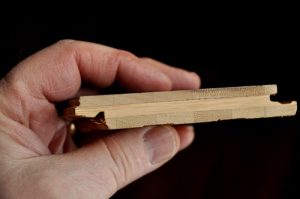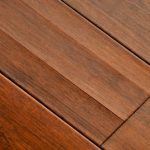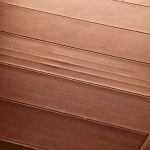April 2015
 You’ve heard about potential problems with relative humidity (RH) – why it varies from season to season and what humid air can do to cold windows and their frames.
You’ve heard about potential problems with relative humidity (RH) – why it varies from season to season and what humid air can do to cold windows and their frames.
Against that background, here’s my story about the choice of flooring for our suite. Two years ago, we chose Engineered Bamboo in a nice dark chestnut colour. It’s “uniclic” and individual boards have fancy edges so they “click” together to form one continuous sheet of wood wall to wall.
The colour is much deeper than natural bamboo, and is likely “carbonized”, made brown by cooking starches in the wood–a little like making sugar by caramelizing it with heat. This process softens the bamboo by about 30%, a fact not often mentioned in sales literature. Furniture and dropped objects leave more noticeable dents than in traditional hardwood.
Our floor has another problem — it’s cracking along the length of the boards. While it was installed correctly, the cracks began to occur when the RH decreased in the winter (we could actually hear a board give way in the quiet of the night). Most of the cracks happened in the first winter, but the second winter just past saw a number of new cracks appear. When the RH decreases, the top surface of the wood shrinks and, because it’s glued to a number of other plies, it has nowhere to go but to crack at the glue-lines. You can see the consistent distance between cracks in boards with multiple cracks. A cracked board has a rough feel–the crack itself is raised above the rest of the board. When the RH increases during the summer, the incidence of new cracking slowly decreases as well, but the old cracks remain. Because the wood expands the cracks are raised less and less apparent, but not healed.
(we could actually hear a board give way in the quiet of the night). Most of the cracks happened in the first winter, but the second winter just past saw a number of new cracks appear. When the RH decreases, the top surface of the wood shrinks and, because it’s glued to a number of other plies, it has nowhere to go but to crack at the glue-lines. You can see the consistent distance between cracks in boards with multiple cracks. A cracked board has a rough feel–the crack itself is raised above the rest of the board. When the RH increases during the summer, the incidence of new cracking slowly decreases as well, but the old cracks remain. Because the wood expands the cracks are raised less and less apparent, but not healed.
So, low RH is likely a major contributing cause of my floor problem. Other contenders are harvesting the bamboo when it’s immature which decreases its resilience to dry conditions, poor quality glues and other manufacturing methods. China produces most of the world’s bamboo flooring and the quality of the product is said to vary widely.
What can one do?
Consider carefully whether you want to use bamboo. Natural colour bamboo will be more resistant to denting than brown (caramelized) wood.
The manufacturers caution against low RH, sometimes quoting a 30% minimum. That’s hard to achieve in our building because humidity is not added to our corridor air and when it gets very cold outside the indoor RH plummets. Reliably adding moisture to the frequently changing air in our suites is a challenge and, as we’ve seen, too much of this “good thing” for the flooring can create damaging condensation on the windows.
We’re cautioned to carefully select a responsible dealer when choosing bamboo products, but I question whether that retailer can know the harvesting conditions, glue quality and manufacturing techniques of the wood supplied to it from the other side of the globe. Our RH conditions in a cold spell in winter could invalidate the warranty with respect to cracking.
Coming up with a beautiful, resilient and long-lasting flooring choice wasn’t easy. And now that we’ve made it, I believe that doing more research and viewing some first-hand examples could have modified or changed our final choice.
This article appeared in the June 2014 issue of Manhattan Matters (Manhattan Place Newsletter) and has been reprinted with permission.



